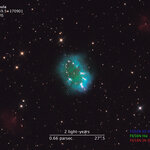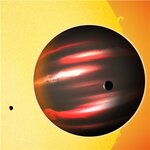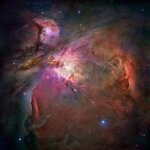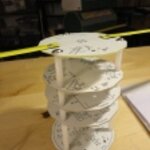Space

Analysis of a piece of lunar rock brought back to Earth by the Apollo 16 mission in 1972 has shown that we may have been wrong about the age of the Moon.
It is commonly accepted that the Moon was created by the impact of a large planet-like object and our proto-Earth very early in the evolution of our solar system. The energy of this impact was sufficiently high that the Moon formed from melted material that began with a deep liquid magma ocean. As the Moon cooled, this magma ocean solidified into different mineral components, the lightest of which floated upwards to form the oldest…

A giant cosmic necklace glows brightly in this NASA Hubble Space Telescope image of an object named (surprise) the Necklace Nebula, a recently discovered planetary nebula which is the glowing remains of an ordinary, Sun-like star.
The nebula consists of a bright ring, measuring 12 trillion miles across, dotted with dense, bright knots of gas that resemble diamonds in a necklace. The knots glow brightly due to absorption of ultraviolet light from the central stars.
The Necklace Nebula is located 15,000 light-years (4,600 parsecs) away in the constellation Sagitta (the Arrow). In this…

Astronomers writing in Monthly Notices of the Royal Astronomical Society say they have discovered the darkest known exoplanet, a Jupiter-sized gas giant called TrES-2b. Their measurements show that TrES-2b reflects less than one percent of the sunlight falling on it, making it blacker than coal or any planet or moon in our solar system.
By comparison, the Jupiter-sized planet in our solar system (that would be Jupiter) is swathed in bright clouds of ammonia that reflect more than a third of the sunlight reaching it. In contrast, TrES-2b (names such because it was discovered in 2006 by the…
As I am halfway around the world right now, using the magic of the internet and Science 2.0's 'scheduling' function, here is a fun little graphic of 'the universe'. It shows various sizes of things in the universe, particularly how our planets measure against the Sun (hint: we're tiny) and how our Sun measures against other stars (hint again: we're tiny).
Now, my main question is, anyone know the original creator of this work?
AlexTuesdays at The Satellite Diaries and Friday at The Daytime Astronomer (twitter @skyday)

What do you get when you mix Mad Men styling, IKEA how-to, and NASA high tech? In an incredibly terse 1 minute and 28 seconds, with no sound needed, NASA asks "So, You Want to Build a Satellite?" and explains why rocket science is hard. Seriously, this is the sort of video that you don't need sound, and it features no talking heads or chatty scientists. It's an elegant, straightforward wake-up call about the intrinsic difficulties that space exploration brings.
For picosatellites like Project Calliope, we can take a more homebrew view. Our lifetime is 3 months tops,…

Molecules of oxygen have been found in the nearby Orion star-forming complex, the first undisputed detection of oxygen molecules in space. Previous missions looking for the molecular variety, two atoms of oxygen bonded together, had been fruitless.
Yet as interesting as the discovery is, it leads to a bigger question; the observed amount of atomic oxygen is far less than expected. Where is all the oxygen hiding in the cold clouds?
Dark oxygen, anyone?
Maybe, but the more likely answer is that oxygen atoms freeze onto tiny dust grains found floating in space and are converted to…

The question 'what can you do with such a tiny satellite' has many answers. This week we're looking at Calliope's faster, cooler cousin, the ion-drive testing platform called FRETS1.
An ion engine in a satellite the size of a soda can
The 'Fluid&Reason Test Satellite 1' (FRETS1), designed in white for thermal reasons, will test an experimental ion engine. Ion engines are basically an electric thruster. They are a rocket type that uses electricity to accelerate ions. Ion engines do not provide a powerful thrust, but they have excellent efficiency (technically, 'a…

Today I received the news release that the first joint meeting of the European Planetary Science Congress and the Division for Planetary Sciences (EPSC-DPS) of the American Astronomical Society 2011 will be held October 2 to 7 in Nantes, France, at La Cité Internationale des Congrès Nantes Métropole.
This program, which will cover diverse planetary topics, is being organized and supported by the European Geosciences Union and the Université de Nantes. Over 1700 abstracts for presentations have been submitted, so far.
Highlights: The latest from MESSENGER, Kepler, Venus Express and Dawn,…

Astronomers have discovered the largest and farthest reservoir of water ever detected in the universe in a quasar called APM 08279+5255 - enough water to fill Earth's oceans more than 100 trillion times.
The distant quasar is one of the most powerful known objects in the universe and has an energy output of 1,000 trillion suns, about 65,000 times that of our Milky Way galaxy. The power of APM 08279+5255 comes from matter spiraling into the quasar's central supermassive black hole, estimated at some 20 billion times the mass of our sun.
The discovery was made with a spectrograph…

Antonio Carusone, describing himself as "a little obsessed with finding vintage design materials", has a look at NASA Graphic designs, circa 1970s. Specifically, he hunted up this 1976 NASA Graphics Standards Manual. Amidst the glories of clean modern design is the famous NASA 'worm' logo, which in 1992 was replaced by the somewhat controversial NASA 'meatball'.
NASA 'worm' logo,used 1975-1992 andcompletely eradicated by 1997
NASA 'meatball' logo,used 1959-82 and 1992-present
What could be controversial about the meatball? Primarily, people…